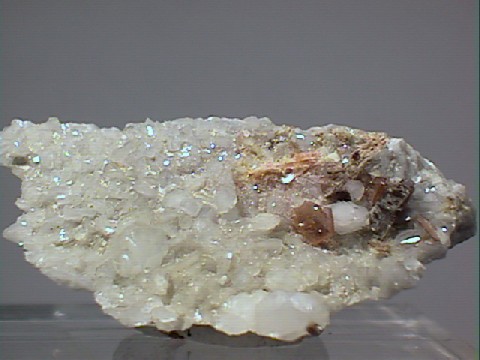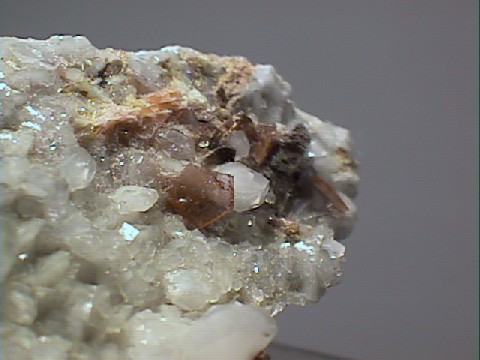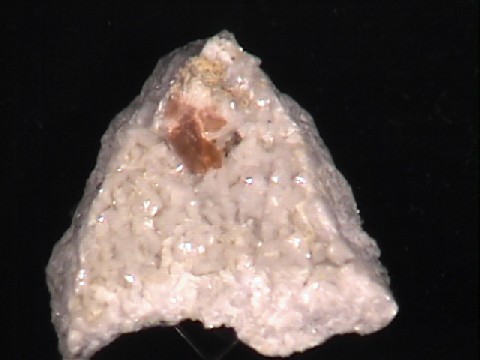 THE MINERAL BASTNASITE
THE MINERAL BASTNASITE
- Chemistry: (Ce, La, Y)CO3F , Cerium Lanthanum Yttrium Carbonate Fluoride.
- Class: Carbonates
- Groups: Rare earth carbonates and Bastnasite.
- Uses: As an important ore of cerium and other rare earth metals and as mineral specimens.
Specimens
Bastnasite, which is sometimes spelled as bastnaesite, is one of a few rare earth carbonate minerals.
Other rare earth carbonate minerals include
Bastnasite has cerium, lanthanum and yttrium in its generalized formula but officially the mineral is divided into three minerals based on the predominant rare earth element. There is Bastnasite-(Ce) with a more accurate formula of (Ce, La)CO3F. There is also Bastnasite-(La) with a formula of (La, Ce)CO3F. And finally there is Bastnasite-(Y) with a formula of (Y, Ce)CO3F. There is little difference in the three in terms of physical properties and most bastnasite is bastnasite-(Ce). Cerium in most natural bastnasites usually far and away dominates the others. Bastnasite and the phosphate mineral monazite are the two largest sources of cerium, an important industrial metal.
Bastnasite is closely related to the mineral parisite The two are both rare earth fluoro-carbonates, but parisite's formula of Ca(Ce, La, Nd)2(CO3)3F2 contains a calcium (and a small amount of neodymium) and a different ratio of constituent ions. Parisite could be viewed as a molecule of calcite (CaCO3) added to two molecules of bastnasite. In fact, the two have been shown to alter back and forth with the addition or loss of CaCO3 in natural environments.
Bastnasite forms a series with the mineral hydroxylbasnasite. The two are members of a substitution series that involves the possible substitution of fluorine ions for hydroxyl (OH) ion groups. Hydroxylbasnasite has a formula of (Ce, La)CO3(OH, F). Not an obviously significant difference, but significant enough to warrant a new mineral. X-ray studies confirm that the hydroxyl ion groups increase the unit cells of the structure and crystallographically and mineralogically this is significant.
The structure of bastnasite is made up of stacks of carbonate ion layers and CeF layers. The CeF layers form flat hexagonal sheets with each cerium bonded to three fluorines. The carbonate layers are more complex with angled carbonate triangular groups. The structure is closely studied because it is one of the few rare earth mineral structures that can accommodate variously sized cations.
Bastnasite gets its name from its type locality, Bastnas Mine, Riddarhyttan, Vastmanland, Sweden.
Although a scarce mineral and never in great concentrations, it is wide spread and one of the more common rare earth carbonates.
Bastnasite has been found in karst bauxite deposits in Hungary, Greece and the Balkans.
Also found in carbonatites, a rare carbonate igneous intrusive rock, at Fen, Norway; Bayan Obo, Mongolia; Kangankunde, Malawi; Kizilcaoren, Turkey and Mountain Pass, California, USA.
At Mountain Pass, bastnasite is the leading ore mineral.
Some bastnasite has been found in the unusual granites of the
PHYSICAL CHARACTERISTICS:
- Color is pale white, tan, gray, brown, yellow and pink.
- Luster is pearly, vitreous, greasy to dull.
- Transparency: Crystals are translucent to opaque.
- Crystal System is hexagonal.
- Crystal Habits include small hexagonal rounded flakes and short prismatic crystals, also in rosettes and spheres as well as massive and granular. Bastnasite has been known to replace (pseudomorph) crystals of allanite.
- Cleavage is distinct in one direction (basal) and poor in three directions (prismatic).
- Fracture is uneven.
- Hardness is 4 to 4.5.
- Specific Gravity is 4.7 to 5.0 (well above average)
- Streak is white.
- Associated Minerals are extensive and include albite,
analcime,
monazite,
hematite,
amphiboles,
aegirine,
rutile,
rhodochrosite,
ancylite-(Ce) , calcite, apophyllite, cordylite,ashcroftine , fluorite, galena,donnayite , epididymite, apatite, serandite, zircon, elpidite, natrolite, pyrochlore,pyrophanite , astrophyllite, barite, brookite, leucophanite, lorenzenite, quartz, synchysite-(Ce), parisite, dolomite, strontianite, siderite and ankerite. - Notable Occurrences include the type locality at Bastnas Mine, Riddarhyttan, Vastmanland, Sweden
as well as Fen, Norway; Bayan Obo, Mongolia; Kangankunde, Malawi; Kizilcaoren, Turkey;
langesundsfjord area, Norway; Kola Peninsula, Russia; Mountain Pass, California, USA; Hungary; Greece; several sites in the Balkans; Mont Saint-Hilaire mines, Ontario and Thor Lake deposits, Northwest Territories, Canada. - Best Field Indicators: crystal habit, color, cleavage, density, luster and locality.





